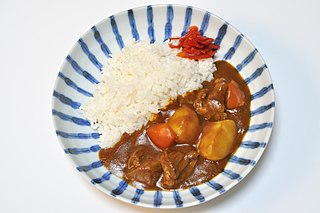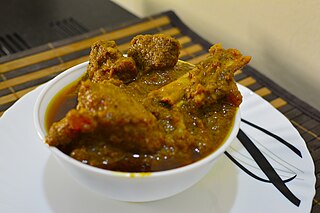In Indian cuisine, a rice and three restaurant is one where the customer picks three curries from a selection, which are served over rice. [1] The concept is derived from the thali style of service. [2]
The concept was claimed to have been created by the This and That restaurant in the Northern Quarter, Greater Manchester during the 1980s. [3]

Curry is a dish with a sauce or gravy seasoned with spices, mainly derived from the interchange of Indian cuisine with European taste in food, starting with the Portuguese, followed by the Dutch and British, and then thoroughly internationalised. Many dishes that would be described as curries in English are found in the native cuisines of countries in Southeast Asia and East Asia. The English word is derived indirectly from some combination of Dravidian words such as the Tamil kaṟi (கறி) meaning 'sauce' or 'relish for rice'.

Japanese cuisine encompasses the regional and traditional foods of Japan, which have developed through centuries of political, economic, and social changes. The traditional cuisine of Japan is based on rice with miso soup and other dishes with an emphasis on seasonal ingredients. Side dishes often consist of fish, pickled vegetables, and vegetables cooked in broth. Common seafood is often grilled, but it is also sometimes served raw as sashimi or as sushi. Seafood and vegetables are also deep-fried in a light batter, as tempura. Apart from rice, a staple includes noodles, such as soba and udon. Japan also has many simmered dishes, such as fish products in broth called oden, or beef in sukiyaki and nikujaga.

Thai cuisine is the national cuisine of Thailand.

A dosa, dosey, dosai, dosha is a thin, savoury crepe in Indian cuisine made from a fermented batter of ground black gram and rice. Dosas are served hot, often with chutney and sambar. Dosas are a common food in Southern India and in Sri Lanka.

Fried rice is a dish of cooked rice that has been stir-fried in a wok or a frying pan and is usually mixed with other ingredients such as eggs, vegetables, seafood, or meat. It is often eaten by itself or as an accompaniment to another dish. Fried rice is a popular component of East Asian, Southeast Asian and certain South Asian cuisines, as well as a staple national dish of Indonesia. As a homemade dish, fried rice is typically made with ingredients left over from other dishes, leading to countless variations. Fried rice first developed during the Sui dynasty in China.

Anglo-Indian cuisine is the cuisine that developed during the British Raj in India. The cuisine introduced dishes such as curry, chutney, kedgeree, mulligatawny and pish pash to English palates.

Nasi kandar is a popular northern Malaysian dish from Penang, originally introduced by Tamil Muslim traders from India. The meal consists of steamed rice combined with an array of distinct curries, side dishes, and gravies. The selection of curries consists of various blends of vegetables, seafood or meat.

Mattar paneer, also known as matar paneer, muttar paneer, and mutter paneer, is a modern restaurant-style and vegetarian North Indian dish consisting of peas and paneer in a tomato-based sauce, spiced with garam masala.

Bangladeshi cuisine has been shaped by the region's history and river-line geography. Bangladesh has a tropical monsoon climate. The staple of Bangladesh is rice and fish. The majority of Bangladeshi people are ethnic Bengali, accustomed to Bengali cuisine, with a minority of non-Bengalis, many used to cuisines from different traditions and regions.

Japanese curry is commonly served in three main forms: curry over rice, curry udon, and curry bread. It is one of the most popular dishes in Japan. The very common "curry rice" is most often referred to simply as "curry".
Udupi cuisine is a cuisine of South India. It forms an important part of Tuluva cuisine and takes its name from Udupi, a city on the southwest coast of India in the Tulunadu region of the state of Karnataka.

Marrybrown Sdn Bhd is a Malaysian-owned multinational chain of quick service restaurants based in Johor Bahru, Johor. Being one of the largest global halal fast food-establishments, the chain has since expanded to over 250 locations throughout Malaysia and across several countries. The restaurant focuses on Malaysian and western dishes.

House Foods Corporation is one of Japan's largest food manufacturers and brands. It began in 1913 in Osaka as Urakami Shoten and began selling curry in 1926.

Padang dish or Minangkabau dish is the cuisine of the Minangkabau people of West Sumatra, Indonesia. It is among the most popular cuisines in Maritime Southeast Asia. It is known across Indonesia as Masakan Padang after Padang, the capital city of Western Sumatra province. It is served in restaurants mostly owned by perantauan (migrating) Minangkabau people in Indonesian cities. Padang food is ubiquitous in Indonesian cities and is popular in neighboring Malaysia and Singapore.

The cuisine of Mauritius is greatly influenced by the tropical location of the island as well as the cultural diversity which characterizes the country. Mauritian cuisine is a blend of African, Chinese, European and Indian influences in the history of Mauritius. Most of the dishes and culinary traditions are inspired by French culture, former African slaves, Indian workers and Chinese migrants that arrived in the country during the 19th century. Over the years, communities found in Mauritius have adapted and mixed each other's cuisine to their liking, resulting in the development of Mauritian cuisine. While some popular dishes and desserts are consumed by Mauritians of all ethnic groups or communities, there are also forms of cuisines which remain unique to a specific ethnic community due to their ancestral cultural and historical connections. Local food therefore reflects the strong traditional, cultural, and historical influences of each community. French cuisine and Sino-Mauritian cuisine are very popular in Mauritius.

Mutton curry is a dish that is prepared from goat meat and vegetables. The dish is found in different variations across all states, countries and regions of the Indian subcontinent and the Caribbean.

Khao soi or khao soy is a Chin Haw dish served in Laos and northern Thailand. A comparable dish, ohn no khao swè, is widely served in Myanmar. In Myanmar, it is known as "khao swè", an adaptation of the original name. Traditionally, the dough for the wheat noodles is spread out on a cloth stretched over boiling water. After steaming, the sheet noodles are rolled and cut with scissors.

Nasi campur, also known as nasi rames or sego campur in Java, refers to an Indonesian and Malay dish of a scoop of nasi putih accompanied by small portions of several other dishes, which includes meats, vegetables, peanuts, eggs, and fried-shrimp krupuk.

Dishoom is a small Bombay (Mumbai)-inspired restaurant group with locations throughout the UK.

Desi PDX, or DesiPDX, is an Indian restaurant in Portland, Oregon.